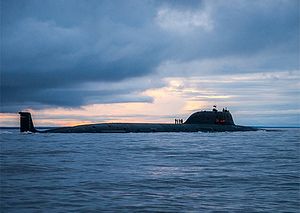The Russian Navy is expecting to launch two new nuclear-powered submarines in 2017, according to the Russian Navy Deputy Commander-in-Chief Vice-Admiral Viktor Bursuk. “In 2017, the first improved Project 955-A submarine and the Yasen-M will be floated out,” Bursuk told TASS News Agency on December 23.
The two new boats belong to the Russian Navy’s two most advanced classes of submarines, the nuclear-powered ballistic missile submarine Project 955A Borei II-class (“North Wind”) aka Dolgorukiy-class and the nuclear-powered multipurpose attack submarine Project 855 Yasen-class. The Project 955A Borei-II class is an improved variant of the Project 955 Borei-class, the new sea leg of Russia’s nuclear triad replacing Soviet-era Project 941 Typhoon-class and Project 667 BDRM Delta IV-class subs.
The Project 955A Borei II-class Knyaz Vladimir was laid down on July 30, 2012 at the Sevmash shipyards in Severodvinsk, a port city on Russia’s White Sea in Arkhangelsk Oblast and will likely be commissioned in 2018. According to Bursuk, the Russian Navy expects delivery of the new subs “within the time limits stipulated by the contract.” Russia plans to operate a total of eight Borei-class boomers–three Borei-class and five improved Borei II-class SSBNs–by the 2020s.
As I reportedly previously (See: “Russia Will Start Constructing New Ballistic Missile Submarine in December”):
In comparison to the Borei-class, Borei II-class submarines are fitted with four additional missile tubes, boast smaller hulls and cons, and feature improved acoustics and lower sound levels, next to a number of other technical improvements. Both variants of Borei-class subs will be armed with Bulava (RSM-56) intercontinental ballistic missiles (ICBMs). The Borei-class will be capable of carrying up to 16 Bulava ICBMs, whereas the improved Borei II-class can carry up to 20 ballistic missiles.
The improved variant of the Borei-class will be capable of launching 96-200 hypersonic, independently maneuverable warheads, yielding 100-150 kilotons apiece. There are currently three Borei-class subs active in the Russian Navy: The Alexander Nevsky and the Vladimir Monomakh are both serving in Russia’s Pacific Fleet, whereas the Yuri Dolgoruky, serves in in the country’s Northern Fleet.
There is currently only one Yasen-class attack submarine, the K-329 Severodvinsk, serving in the Russian Navy. As I noted elsewhere, the introduction of the Yasen-class subs has been hampered by repeated delays (See: “Groundhog Day: ‘Russia Developing 5th Generation Sub’”):
[W]aiting for the completion of the Yasen project could take a while. The 13,800-ton, 390-foot long and highly automated Yasen-class of Russian attack submarines was supposed to replace older Soviet-era multi-purpose nuclear submarine models by 2020.
Yet, the exorbitant costs of the submarines — estimated to be twice as much as the new Borei-class SSBNs – has so far led only to the commissioning of one out of eight SSGNs, with a further three to four vessels to be completed by 2020.
However, it appears unlikely that Russia’s shipbuilding industry will be able to complete more than two Yasen-class subs by 2020 due to financial constraints. The Yasen-class Severodvinsk has been undergoing sea trials since 2011 due to various technical issues with the boat and it unclear whether the submarine is operational or not, although it allegedly completed its first mission in August 2016. The Project 885-M Yasen M-class Kazan, laid down already in 2009, is an improved variant of the Yasen-class and reportedly will be one of the quietest subs ever to be commissioned into the Russian Navy.
The Yasen M-class and both variants of the Borei-class are also expected to be fitted with a new deep-water torpedo in 2017 (See: “Russia’s Deadliest Subs to Receive New Heat-Seeking Torpedos”).
































